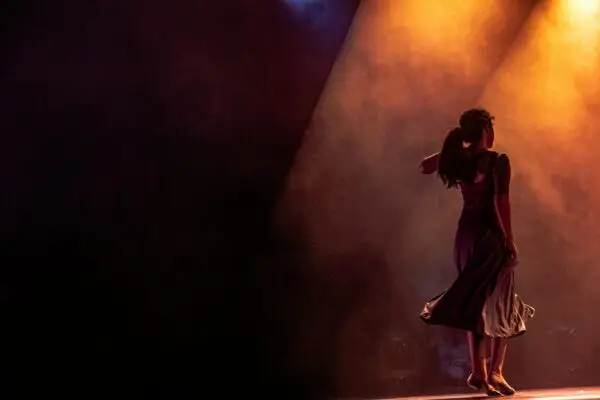Whcih are the best flamenco palos? Flamenco is a deeply expressive art form that blends music, song, and dance, originating in the Andalusian region of Spain. It is known for its emotional depth, complex rhythms, and rich cultural history, with roots in Romani, Moorish, Jewish, and Andalusian traditions. One of the most unique aspects of flamenco is its use of palos, or styles, which refer to distinct musical forms within the genre. Each palo has its own rhythm, structure, and mood, reflecting a range of human emotions and experiences.
Here, we will explore some of the most important palos in flamenco, offering insight into the characteristics that make each style unique.
1. Soleá
The soleá, widely revered as the «mother of all palos,» stands as a cornerstone and ancient style within the vibrant world of flamenco. Its very name, derived from the Spanish word soledad (solitude), perfectly encapsulates its essence. It’s characterized by a slow, deliberate, somber, and profoundly melancholic rhythm, typically adhering to a 12-beat compás. This intricate rhythmic framework, often accented on beats 3, 6, 8, 10, and 12, creates a unique tension and release that is a hallmark of flamenco’s emotional power.
The lyrics, or letras, of the soleá frequently delve into the deepest human emotions, exploring themes of loneliness, heartbreak, longing, and existential reflection. This deep emotional expression is conveyed through the cantaor’s (singer’s) masterful use of vocal techniques like melisma and dynamic phrasing, allowing them to stretch and ornament notes to convey profound feeling. The mood of the soleá is consistently solemn, introspective, and profound, inviting both performer and listener into a space of sorrow, despair, and deep reflection.
Beyond the cante (singing), the soleá is also a pivotal style for the flamenco guitar (toque) and dance (baile). The guitar accompaniment is equally expressive, employing techniques like rasgueado (strumming) and picado (plucking) to enhance the dramatic arc of the performance. The interplay between singer and guitarist is crucial, a dynamic conversation where each responds to the other’s emotional cues. For the bailaora (female dancer), the soleá offers a powerful canvas for expression, with movements characterized by fluid arm work (braceos), undulating hips, and sharp waist breaks, often punctuated by powerful footwork (zapateado). The solemnity and seriousness required from the artist in a soleá performance further underscore its profound emotional depth.
Historically, the soleá emerged in the 19th century, evolving from Andalusian folk songs and earlier flamenco forms. It gained prominence in the intimate settings of early flamenco gatherings before becoming a staple in the cafés cantantes of the late 19th century. Its roots in the struggles and emotions of marginalized communities imbued it with a raw, authentic character that continues to resonate deeply.
While the fundamental characteristics remain, the soleá has given rise to numerous styles and variants, often associated with specific regions and artists within Andalusia. Examples include the Soleá de Triana, Soleá de Cádiz, Soleá de Jerez, Soleá de Alcalá, and Soleá de Utrera, each carrying subtle nuances in rhythm, melody, and interpretation. This rich diversity within the soleá underscores its enduring influence and its position as the rhythmic and emotional bedrock of much of flamenco art.
2. Alegrías
In vibrant contrast to the solemnity and introspective depth of the soleá, the alegrías bursts forth as a profoundly lively and festive palo within flamenco. As its name, meaning «joys,» clearly implies, this style is imbued with an upbeat rhythm and a contagiously joyful spirit, making it synonymous with celebrations and happy occasions.
Originating from the sun-drenched Cádiz region of Andalusia, a city known for its spirited carnaval and lighthearted character, alegrías share the fundamental 12-beat rhythm (compás) with soleá. However, the crucial differentiator lies in its much faster tempo. This accelerated pace transforms the rhythmic framework into a dynamic and exhilarating experience, emphasizing rapid footwork (zapateado) and graceful, expressive arm movements (braceos) in the dance.
The lyrics of alegrías often reflect its cheerful nature, frequently celebrating the beauty of Cádiz, its vibrant culture, and themes of love and admiration, but always with a bright and optimistic slant. Unlike the mournful ayes that open a soleá, the alegrías frequently begin with a distinctive and rapid «tiriti, tran, tran, tran,» setting an immediate tone of exuberance.
For dancers, the alegrías offers a canvas for showcasing virtuosity and playful expression. Performances are typically sassy, brilliant, and showy, often incorporating elements like coquettish looks and flashy turns. Dancers commonly wear vibrant colors and may utilize traditional accessories like the mantón (shawl) and bata de cola (long-tailed dress), which add to the visual spectacle and celebratory mood.
The structure of a baile por alegrías (alegrías dance) is one of the most formalized in flamenco, often including specific sections such as the salida (entrance), paseo (walk-around), silencio (a brief, slow, and dramatic section where the guitarist plays a specific melodic theme, allowing the dancer a moment of poised stillness), castellana (an upbeat section), escobilla (a complex footwork sequence), and typically culminating in a lively bulerías de Cádiz section. This structured yet dynamic progression contributes to its appeal in both tablaos and larger theatrical performances.
While sharing the same rhythmic compás as soleá, the alegrías stands as its joyful counterpoint, embodying the lighter, more celebratory side of flamenco, a testament to the art form’s incredible emotional range.
- Mood: Joyful, celebratory, vibrant.
- Rhythm: 12 beats.
- Themes: Happiness, love, festivity.
3. Bulerías
The bulerías stands as perhaps the most rhythmically complex and exhilaratingly fast-paced palo in the entire flamenco repertoire. While it shares the foundational 12-beat compás with soleá and alegrías, its true mastery lies in its inherent unpredictability and shifting accents, which can be challenging even for seasoned flamenco artists. This makes the bulerías a true test of a performer’s intuition, technical prowess, and deep understanding of flamenco’s improvisational spirit.
Originating from Jerez de la Frontera, just a short distance from San Fernando, the bulerías embodies the spontaneous and communal spirit of flamenco gatherings (juergas). Its name is thought to derive from «bulla» (noise, uproar) or «burla» (mockery), reflecting its boisterous, playful, and often mischievous character.
The rapid tempo of the bulerías, combined with its elastic interpretation of the 12-beat cycle, allows for immense freedom and improvisation from all performers. While the core compás is present, the accents can be placed in unexpected ways, creating a thrilling push-and-pull with the underlying rhythm. This demands incredible agility from the guitarist, who must provide a responsive and equally dynamic accompaniment, and from the cantaor (singer), who often delivers short, sharp, and witty letras (lyrics).
For dancers, the bulerías is a showcase of virtuosity and personality. It’s often performed in a circle at the end of a fiesta, where each individual takes a turn to step into the center and perform a short, electrifying burst of dance. The movements are quick, sharp, and improvisational, reflecting the dancer’s individual flair and rhythmic sensibility. Powerful zapateado (footwork), intricate braceos (arm movements), and expressive body language combine to create a captivating spectacle. The «unpredictable accents» mean that a dancer must possess an innate compás and the ability to listen and respond instantly to the nuances of the music and other performers.
The themes of bulerías lyrics are as varied as its accents, often reflecting everyday life, humor, social commentary, and lighthearted tales. Unlike the profound sorrow of soleá or the pure joy of alegrías, bulerías embraces a broader spectrum of emotions, often with a mischievous or ironic twist.
Its place as a common closing piece in flamenco performances is no accident. The bulerías provides a high-energy finale, allowing artists to collectively demonstrate their technical brilliance and passionate connection to the art form, leaving audiences exhilarated and often on their feet. It is precisely this challenging yet liberating rhythmic framework that makes the bulerías one of the most beloved and defining expressions of flamenco.
- Mood: Playful, energetic, mischievous.
- Rhythm: 12 beats, with irregular accents.
- Themes: Celebration, humor, spontaneity.
4. Fandango
The fandango is a palo with many regional variations, but its defining feature is its 6/8 or 3/4 rhythm. Fandangos are often upbeat and are sung with a lot of vocal ornamentation. One of the most popular variations is the Fandango de Huelva, which is associated with the province of Huelva in Andalusia.
- Mood: Varied—ranging from lively to melancholic, depending on the style.
- Rhythm: 6/8 or 3/4 time.
- Themes: Nature, love, the countryside.
5. Siguiriyas
If soleá is the mother of flamenco, the siguiriyas could be considered its darkest child. This palo is deeply tragic and intense, often conveying themes of death, pain, and loss. Siguiriyas follows a 12-beat rhythm, but its accentuation is more irregular than in other palos, giving it a distinct mournful and almost haunting sound.
- Mood: Tragic, sorrowful, profound.
- Rhythm: 12 beats, with irregular accents.
- Themes: Death, suffering, existential grief.
6. Tangos
Despite a shared name, the flamenco tangos should absolutely not be confused with the Argentine tango; they are distinct art forms with different origins and characteristics. While both evoke passion, their musical structures, dance styles, and instrumentation set them apart.
Flamenco tangos are a highly rhythmic and remarkably accessible palo within the flamenco repertoire. Compared to the intricate compás of soleá or the unpredictable nature of bulerías, tangos are generally less complex, making them a popular entry point for both aspiring flamenco artists and audiences.
A key distinguishing feature of flamenco tangos is its straightforward 4/4 rhythm. This binary meter provides a clear and consistent pulse, making it easier to follow and engage with. This solid rhythmic foundation allows for a more direct and often playful and sensual expression, which contributes significantly to its widespread popularity among singers and dancers.
The themes in flamenco tangos often lean towards lightheartedness, everyday life, and even witty observations. The lyrics can be teasing, flirtatious, or tell simple stories, contrasting sharply with the deeper, more melancholic themes found in some other palos. This approachable lyrical content, combined with the infectious rhythm, makes tangos a favorite for spontaneous performances and social gatherings.
For dancers, flamenco tangos offer ample opportunity for elegant and expressive movements. The 4/4 rhythm allows for a more grounded and sometimes more overtly sensual style than other flamenco dances. While it can certainly showcase intricate footwork, the emphasis often lies on body movement, arm fluidity, and an engaging presence.
Historically, flamenco tangos are believed to have origins in the lively port cities of Andalusia, particularly Cádiz and Seville, and may have been influenced by Afro-Cuban rhythms that traveled across the Atlantic, contributing to the broader category of «cantes de ida y vuelta» (songs of a round trip). Over time, these influences fused with existing Andalusian musical traditions to form the unique flamenco tangos we know today.
Various regional styles of tangos exist, such as Tangos de Cádiz, Tangos de Triana (Seville), Tangos de Granada, and Tangos de Málaga, each carrying its own subtle melodic and rhythmic nuances. However, the fundamental characteristics of a clear 4/4 rhythm, an engaging and often playful mood, and its relative accessibility remain constant, cementing its status as one of flamenco’s most beloved and versatile palos.
- Mood: Sensual, playful, rhythmic.
- Rhythm: 4/4.
- Themes: Love, flirtation, everyday life.
7. Tarantos: the best flamenco palos
The taranto is a style that originates from the mining regions of Almería and Murcia in southeastern Spain. It is a slow palo with a serious tone, and its lyrics often deal with the harshness of life in the mines. The taranto shares some similarities with fandango but is typically more solemn in nature.
- Mood: Serious, reflective.
- Rhythm: Free rhythm, transitioning into 4/4 time.
- Themes: Hardship, life in the mines, struggle.
8. Sevillanas
The sevillanas are not just a flamenco palo; they are an intrinsic cultural phenomenon, inextricably linked with the vibrant city of Seville and, most notably, its spectacular annual Feria de Abril (April Fair). While they share rhythmic elements with flamenco, sevillanas occupy a unique and beloved space as one of the most popular and widely practiced forms of folk dance in Spain, particularly throughout Andalusia.
What truly defines the sevillanas is its highly structured and easily recognizable four-part structure. Each of the four coplas (stanzas or sections) has its own distinct choreography, and dancers often perform a series of turns and changes in partner position that are standardized across the region. This makes them accessible and relatively easy to learn, allowing people from all walks of life to participate in the joyous social dancing during ferias and other celebrations.
Characterized by a consistently lively tempo and a joyful spirit, sevillanas are almost always danced in pairs. The dancers face each other, engaging in a graceful interplay of arm movements (braceos), subtle footwork, and elegant body postures, all while maintaining eye contact and a playful rapport. The movements are often described as elegant and flirtatious, embodying the festive atmosphere of the Andalusian fairs.
The accompaniment for sevillanas is typically provided by joyful singing (cante), often with lyrics that celebrate love, nature, the beauty of Seville, and the spirit of the Feria. The music is light and melodic, and the guitar provides a driving rhythm that supports the dance. In addition to the guitar and singing, castanets are a common and delightful accompaniment, with dancers often playing them while they move, adding another layer of percussive rhythm.
Unlike many other flamenco palos that demand years of dedicated study and often solitary practice, sevillanas are inherently a social dance. They are learned in dance schools, at family gatherings, and in local peñas (flamenco clubs) across Andalusia, making them a cornerstone of community life. Their accessibility and festive nature mean that virtually anyone, from children to the elderly, can join in the dancing during the Feria de Abril and other festive occasions, contributing to the infectious atmosphere of celebration.
In essence, sevillanas are more than just a dance; they are a living tradition, a symbol of Sevillian identity, and a vibrant expression of the Andalusian spirit of joy, community, and celebration.
- Mood: Festive, social, lighthearted.
- Rhythm: 3/4.
- Themes: Love, friendship, celebration.
9. Martinetes
The martinete is a unique palo in that it is usually performed a cappella, without the accompaniment of the guitar. It is derived from the songs of blacksmiths and has a strong, rhythmic feel, often imitating the sound of hammering on an anvil. Martinetes are usually slow and solemn.
- Mood: Strong, rhythmic, serious.
- Rhythm: Free, often imitating rhythmic labor.
- Themes: Hard work, suffering, dignity.
10. Guajiras
The guajira is one of the cantes de ida y vuelta (songs of «round trip»), meaning it has influences from Spanish colonies in Latin America, particularly Cuba. Guajiras have a 12-beat rhythm, but the mood is light and tropical, reflecting the influence of Cuban music.
- Mood: Light, tropical, upbeat.
- Rhythm: 12 beats.
- Themes: Nature, love, rural life in Cuba.
Conclusion
Flamenco is a rich and diverse musical tradition, and its many palos provide a wide range of emotional expressions, from the profound sorrow of siguiriyas to the festive energy of alegrías and sevillanas. Each palo serves as a unique window into the cultural and emotional landscape of Andalusia, offering performers and audiences alike an opportunity to connect deeply with the music and its stories. Whether you’re a newcomer to flamenco or a seasoned aficionado, understanding these different styles is key to fully appreciating the complexity and beauty of this art form.



